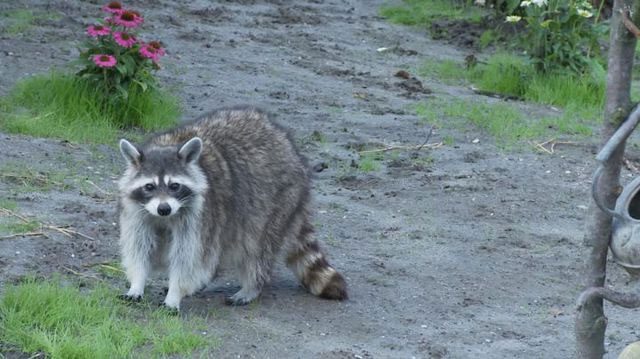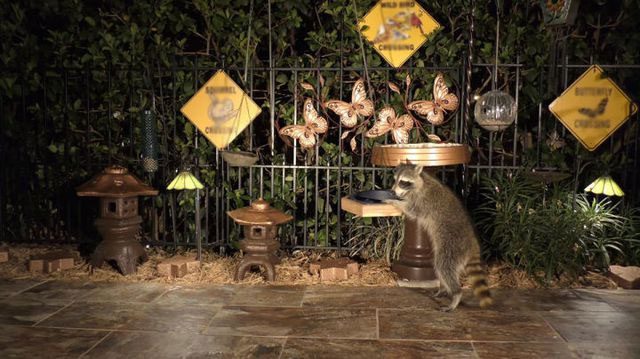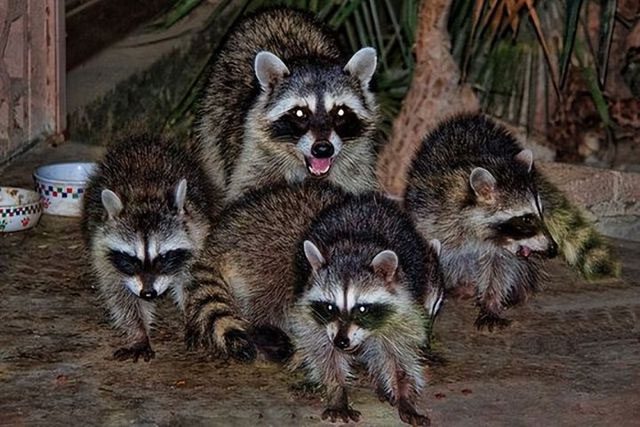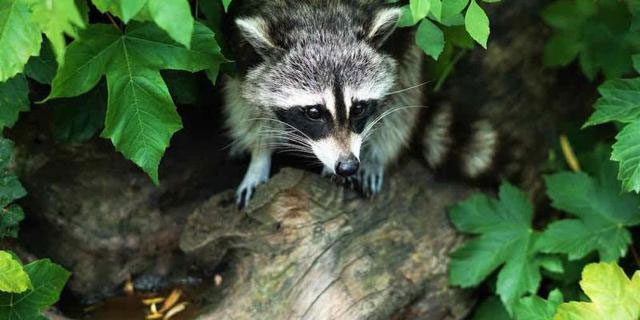We have often heard stories about how, after humans harm animals, those animals eventually come back to seek revenge. But is this really true?
North American Raccoon, as its name suggests, is a medium-sized carnivorous animal native to North America, but it has now spread to most countries in Eurasia. When fully grown, they measure 40-65 cm in length and weigh between 4-10 kg, with males being slightly larger than females.
The appearance of the North American raccoon somewhat resembles that of the panda, leading many to mistakenly believe that they are closely related species. North American raccoons have gray-brown fur with black patches on their faces, resembling a mask. For this reason, they are also known as “masked bandits” because they love to sneak into people’s homes to steal food.
The biggest difference between North American raccoons and pandas lies in their tails and claws.

This is a medium-sized carnivorous animal native to North America
People’s impressions of North American raccoons can be quite polarized. On one hand, many are influenced by films and television shows, such as the character Rocket in “Guardians of the Galaxy,” which is based on a North American raccoon and is loved by many for being an adorable creature.
On the other hand, in North America, France, Denmark, and other places where raccoons live as wild animals, they are not viewed favorably by the public. They often become targets for pursuits, much like how we chase mice away when they enter our homes, and few consider them to be cute.
This negative perception stems from the fact that these animals often take advantage of the night to invade homes in search of food. As North American raccoons are also carnivorous, pets such as birds and kittens can become their prey, and there have even been cases where these animals have attacked humans.

North American raccoons often take advantage of the night to invade homes in search of food.
According to a report in the “World Journal” from the United States, an incident occurred in a Chinese family in Monterey Park, Los Angeles County, Southern California, where a raccoon retaliated against the homeowners by tearing their tent.
It was around ten o’clock at night when the homeowner was watering flowers with a hose outside. During this time, she noticed something unusual in the dark corner near the pool, and upon closer inspection, it turned out to be several North American raccoons.
As she continued to observe, one of the raccoons suddenly jumped up, startling her, prompting her to quickly spray them with the hose. The raccoons then quickly left.
If you think those North American raccoons simply left quietly, you are mistaken, and the entire incident would have gone unnoticed without further reports.
To the homeowner’s surprise, a few minutes later, the raccoons returned, this time standing under a pomegranate tree, all staring intently at her.
This unusual behavior caused the homeowner to feel startled again, and she hurried back inside. The next morning, upon reviewing the camera footage, she discovered that a total of four raccoons had invaded her yard the previous night, likely a pair of parents and their two young.

Four raccoons invaded the yard last night, possibly a pair of parents and their two young.
On the second day, the homeowner checked her garden and found that the tent by the pool had been ripped apart by them. She believed that her action of spraying water the previous night had angered them, leading to their revenge by tearing the tent.
Do animals really know how to seek revenge?
In fact, this is entirely possible and applies to many animal species. Observations show that in some wildlife rescue operations, people will use a piece of cloth to cover the eyes of these animals.
The reason is that the blindfold blocks light, making the process of anesthesia easier—animals will wake up quickly when stimulated by light. However, there is another reason: it prevents them from seeing the people involved in the process, thus unable to seek revenge.
Tammy Miller, a veterinarian at a large cat rescue center near Tampa, Florida, USA, who once treated a lion, noted that the lion might have smelled or seen her during the anesthesia and surgery process. Therefore, when Tammy returned to visit the lion, it displayed aggressive behavior and seemed eager to attack, even attempting to pounce across the enclosure. Previously, this lion had shown no animosity towards Tammy, and its demeanor changed completely after the surgery.

It seems that animals can indeed remember grudges and may engage in acts of revenge.
Conversely, a tiger named Indira in Australia was also treated by veterinarians. During the treatment, its eyes were covered, preventing it from seeing the doctors. Later, when the doctors visited the tiger after the surgery, it showed no unusual behavior.
Additionally, there is a clear example of animals seeking revenge involving a troop of monkeys in India. At the end of 2021, a strange incident occurred in a village in the Bied district of Maharashtra, India, where nearly all the dogs in the village were killed by a troop of monkeys. Over the course of nearly a month, there were more than 300 dogs in the village, but almost all of them were killed by the monkeys.
The monkeys rampaged through the village, brutally attacking the dogs by beating them collectively and throwing them from heights until they died.
Evaluating the behavior of certain animal species in reality, it appears that they can indeed remember grudges and engage in acts of revenge. From this perspective, it is not surprising that after the four North American raccoons were sprayed with water, they retaliated against the homeowner by tearing the tent next to the pool.


















































